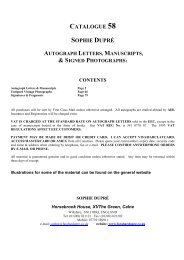CLIVE FARAHAR Catalogue 60
CLIVE FARAHAR Catalogue 60
CLIVE FARAHAR Catalogue 60
Create successful ePaper yourself
Turn your PDF publications into a flip-book with our unique Google optimized e-Paper software.
THE RAMAYANA<br />
151. TAMIL MANUSCRIPT. Finely written Manuscript in Tamil of part of a prose version, in<br />
popular language, of the great Hindu epic the Ramayana, [Southern India], late 18th or early<br />
19th c. on both sides of 205 palm leaves approx. 1½” x 18¼”, 7 or 8 lines to a side, numbered<br />
in Tamil 283-499 but lacking leaves 331, 454-459, 461, 463-464, 481 and 498, each secured by<br />
two holes to the string and wooden stake between the wooden boards, a few leaves chipped or<br />
with tiny worm holes with loss of a few letters, but generally in very good condition, [40022]<br />
£1,250<br />
In a fine hand, skilfully ‘etched’ with a sharp stylus, and then inked with vegetable dye. (For uninked<br />
lettering, see f. 354v, abandoned after 1½ lines, presumably on realising an error).<br />
The leaves are from the latter part of Part 3 (‘Aaranyakaandam’, ‘the Forest Trek’) and from the first<br />
part of Part 4 (‘Kishkindhaakaandam’, starting at leaf 422, see the part title in the margin), out of the<br />
seven parts of the epic. Rama spent 10 years in the forest on his way to recover Sita, his bride-to-be,<br />
and then in Part 4 came to Kishkinda, peopled by a giant monkey race. There he helped to depose Vali,<br />
once a great ruler but now consumed with jealousy.<br />
The original epic, in 24,000 stanzas, was composed in Sanskrit by Valmiki. Traditionally ascribed to<br />
1500 B.C., it may be of the 4th c. B.C. Its stories are known all over India. They are read for many<br />
reasons, as scripture, for their philosophy of life, and for sheer adventure, coupled with scenes of tender<br />
affection, ideals of justice, and descriptions of landscape. The Tamil version by Kamban, in 10,500<br />
stanzas, of the 11th c. A.D., is a work of art in its own right, and from it descend the prose versions such<br />
as the present.<br />
We are grateful to Mrs Nalini Persad of the British Library and to Kalyanasundara Gurukkal for help<br />
in preparing this note.<br />
152. THOMSON (James) The Castle of Indolence: An Allegorical Poem. Written in Imitation of<br />
Spenser, A. Millar, London 1748 ii + 82 pp. + advertisement and explanation leaf 2 pp. 4to.<br />
modern wrappers, printed label on front cover, [12561] £350<br />
153. TIMKOWSKI (George) Travels of the Russian Mission through Mongolia to China, and<br />
Residence in Peking in the Years 1820-1821, with Corrections and Notes by Julius Von<br />
Klaproth, 1827 folding map, folding plan of Peking, frontis, some occasional spotting, large<br />
red chinese library stamp or chop mark on verso of titles and blind stamp of Norman Soong, 2<br />
vols, ix + 468 pp. iv + 496 pp.modern hf. calf, [11313] £750<br />
154. TORREND (J.) A Comparative Grammar of the South-African Bantu Languages, Zanzibar,<br />
Mozambique, the Zambesi, Kafirland, Benguela, Angola, the Congo, the Ogowe, the<br />
Cameroons, the Lake Region, etc. London, 1891 map, roy.8vo, original cloth, some slight<br />
wear, label on upper cover, [CF8042] £125<br />
The author gives in the introduction a History of the Origin of the Bantu, and in the appendicies<br />
Ethnographical Notes, dictated by natives, in Tonga [Matabeleland], On the Rotse and On the<br />
Karanga. He also devotes a whole section to Specimens of Kafir Folk Lore<br />
155. TOUSSAINT (A.) & H.Adolphe. Bibliography of Mauritius (1502-1954) Covering the<br />
Printed Record, Manuscripts, Archivalia and Cartographic Material, Port Louis, 1956 sm.4to,<br />
original printed wrapper, [12689] £100<br />
8865 entries.<br />
156. [UPTON (John)] A New Canto of Spencer’s Fairy Queen. Now first Published, G. Hawkins,<br />
London, 1747 iv + 28 pp. 4to. modern paper wrapper, printed label on upper cover, [12563]<br />
£500<br />
The British Library credits this to Rev. John Upton, Prebendary of Rochester, the Spenser Scholar, who<br />
brought out his own edition of The Faerie Queen in 1758, but qualifying the entry with a question mark.





